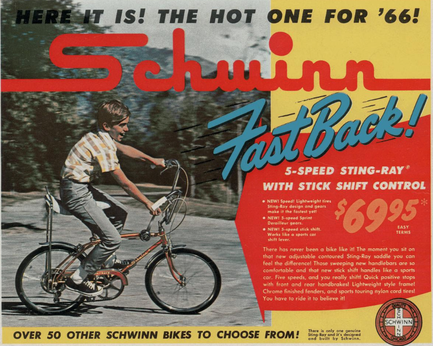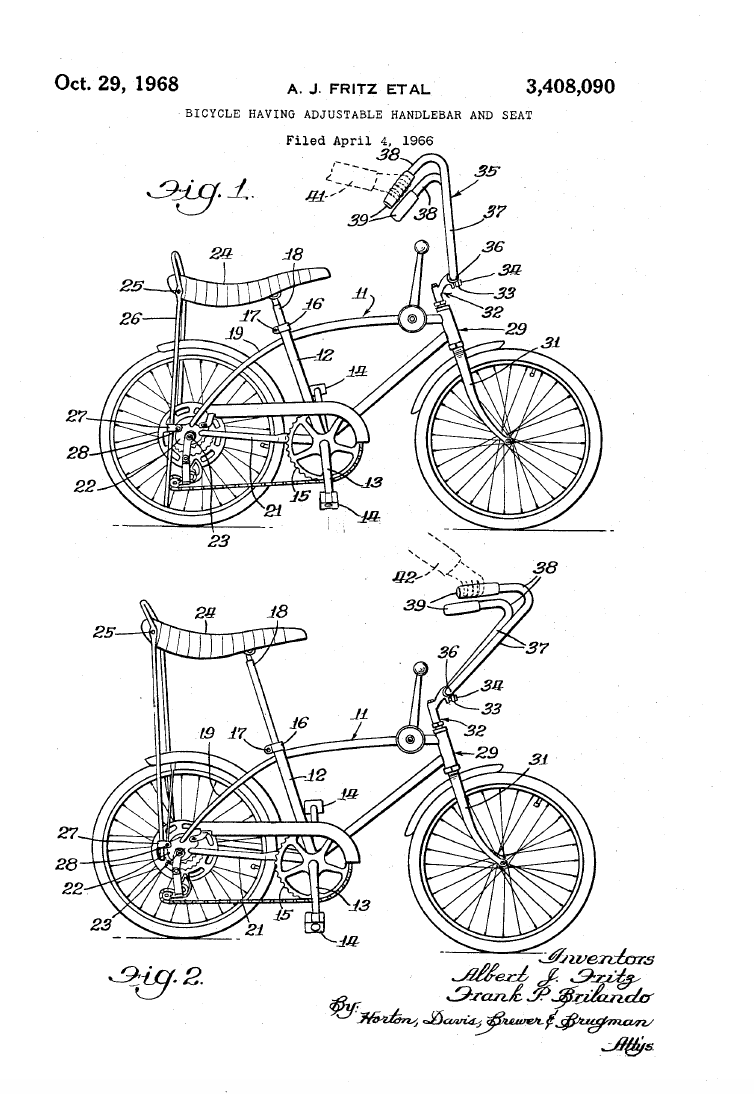
On October 29, 1968, U.S. Patent No.: 3,408,090 issued to Albert J. Fritz and Frank P. Brilando for a "Bicycle having an Adjustable Handlebar and Seat". The '090 patent was assigned to the Schwinn Bicycle Company and covered features of the "Fastback" model of the Stingray line of Schwinn bicycles. The Stingray line was first introduced by Schwinn in 1963 and was modeled after the way kids in Southern California were customizing their bikes to mimic the "chopper" style of motorcycles then in vogue. The kids were customizing their bicycles to have both elongated seats and handlebars. The seats were known as "banana" seats, while the handlebars were known as "butterfly" or "Ape Hanger" handlebars.
Fritz, who was then the director of research and development for Schwinn, noticed the new bicycle fad in California and brought it to the attention of Schwinn management. Although skeptical, Schwinn management allowed Fritz to develop and sell the Stingray bicycle to capitalize on the new fad. Much to management's surprise, the Stingray was an instant success and quickly became Schwinn's top-selling bicycle. The Stingray was marketed as the "bicycle with the sports car look".
In 1966, Schwinn came out with the "Fastback" model of the Stingray bicycle. The main feature that distinguished the "Fastback" model from previous models of the Stingray was a new 5-speed gear shifter that was mounted on the top tube or cross-bar of the frame. The gear shifter was of the "stick shift" type and was connected to a new 5-speed Derailleur gear assembly. Other new features of the Fastback were mechanisms for adjusting the height of the banana seat and the position of the handlebars. A first patent application for the stick shift mechanism was filed on March 9, 1966 and issued as U.S. Patent No.: 3,383,940 on May 21, 1968. A second patent application for the seat and handlebar adjustment mechanisms was filed on April 4, 1966 and issued as the '090 patent.
For a boy growing up in the mid 1960s to the mid 1970s, the Stingray (and in particular, one with a stick shift) was the ultimate bicycle to own.
Fritz, who was then the director of research and development for Schwinn, noticed the new bicycle fad in California and brought it to the attention of Schwinn management. Although skeptical, Schwinn management allowed Fritz to develop and sell the Stingray bicycle to capitalize on the new fad. Much to management's surprise, the Stingray was an instant success and quickly became Schwinn's top-selling bicycle. The Stingray was marketed as the "bicycle with the sports car look".
In 1966, Schwinn came out with the "Fastback" model of the Stingray bicycle. The main feature that distinguished the "Fastback" model from previous models of the Stingray was a new 5-speed gear shifter that was mounted on the top tube or cross-bar of the frame. The gear shifter was of the "stick shift" type and was connected to a new 5-speed Derailleur gear assembly. Other new features of the Fastback were mechanisms for adjusting the height of the banana seat and the position of the handlebars. A first patent application for the stick shift mechanism was filed on March 9, 1966 and issued as U.S. Patent No.: 3,383,940 on May 21, 1968. A second patent application for the seat and handlebar adjustment mechanisms was filed on April 4, 1966 and issued as the '090 patent.
For a boy growing up in the mid 1960s to the mid 1970s, the Stingray (and in particular, one with a stick shift) was the ultimate bicycle to own.


